Jim Moore
-
- Caribbean Security Challenges Maritime Reporter, Mar 2014 #44
The Caribbean is a complex maritime environment, with multiple countries and territories, significant seaborne commerce and a wide variety of threats to safety, security, stability, the environment and sovereignty. A diverse group of stakeholders gathered in Providenciales, Turks and Caicos Islands (TCI) to discuss those challenges and reaffirm their commitment to address them. A major theme throughout the conference was that partnerships and collaboration are important to achieving maritime security in the region.
Maritime Security Caribbean 2013 was hosted by Homeland Security Outlook and held at the Beaches Resort on Providenciales.
The conference was opened by Peter Beckingham, the governor of the Turks and Caicos Islands, an independently governed British overseas territory located south of the Bahamas and north of Haiti and the Dominican Republic. Beckingham acknowledged the substantial maritime security risks of drug and human trafficking and illegal immigration for the TCI. “There is a huge vulnerability about these islands.”
“Maritime security is an ongoing concern for our government. We have lots of beaches—ideal landing areas for trafficking of drugs, humans and firearms, and the removal of endangered or introduction of invasive species,” said Ricardo Don-Hue Gardiner, the TCI minister of border control and labor. Gardiner. “We have a fundamental responsibility to do the very best we can to protect our people and our visitors. No vessel should reach our shores undetected and without scrutiny.”
Among the major challenges to maritime security are illegal landings sloops packed with people who did not go through proper entry process, Gardiner said.
According to Gardiner, the number of illegal migrants who were interdicted was about 900 in 2012, and is on track to be higher this year. “It could reach the equivalent of four percent of our population this year.”
“We have 40 islands and cays, and they’re all pretty small, so it’s challenging to manage all the borders in a really effective manner,” said Colin Farquhar, commissioner of the Royal Turks & Caicos Islands Police Force. The Ministry of Border Control and Labour commissioned a coastal radar station in September 2012, so now we have the ability to respond to targets of interest with a high degree of precision. And so for that we need a different type of vessel. We’ve had to kind of re-look at what kind of vessels do we need in order to respond to targets of interest.”
Because of the radar system, many of those sloops and other vessels have been detected, and their illegal passengers processed and repatriated.
Technology, and in particular a high-resolution surface surveillance radar, is improving the ability of TCI authorities to monitor local waters and respond to potential threats.
“Traffickers are constantly changing techniques, and do not have to work within the rule of law,” said Larry Covington, law enforcement advisor for the British consulate in Miami. “We in law enforcement must work within the rule of law.”
In addition to drugs and human trafficking, Covington said there is also an illegal trade in firearms, and that corresponds with an increase in violent gang activity. “We do not manufacture fire arms in the countries of the Caribbean. But they’re here, and they’re being moved by sea. And they’re being used by the wrong people.”
According to Rodman Johnson, radar supervisor for the TCI, the radar has not only helped detect illegal traffic, but it has also helped with navigational warnings and help to render assistance to more than 30 vessels in distress. Of major concern to the TCI are hard-to-detect sloops from Haiti. The Haitian sloops are 30- to 35-ft. wooden boats, usually loaded with people and low in the water.
There have been sloops with more than 200 people aboard. Some have masts, but some do not. Some have motors, but many do not. They are carried by wind and currently, often at a speed of just a couple of knots. The sloops are a sharp contrast from the “go fast” boats used in other smuggling operations that can reach speeds up to 60 knots.
Jim Moore of Terma North America says the Terma Scanter 2001 radar at Providenciales demonstrates the value of a high-resolution radar to detect small, “non-cooperative” targets in harsh weather and sea state conditions.
The U.S, Coast Guard is committed to the Caribbean and has a visible presence in the area. “We always have a medium endurance cutter on the north coast of Haiti. If we leave, or there is a rumor we will be away from that area, there is an increase in traffic,” said U.S. Coast Guard LCDR Doug Jannusch assigned to the U.S. Embassy in Nassau, Operation Bahamas and Turks and Caicos (OPBAT) is the cork in the bottle. “If we remove the plug, the area will fill back up with drugs.”
Underway with the Turks and Caicos Islands Marine Police
Now that the TCI has a very effective high-resolution surface surveillance radar, the TCI Marine Police has been able to change its tactics and improve their effectiveness and efficiency. Today the Marine Police can rely on the TCI’s coastal surveillance radar to alert them to a potential threat, and dispatch a smaller, more economical boat to investigate when needed. The Royal Turks and Caicos Island Police Force Marine Police also have a twin-engine aircraft for surveillance purposes, but there currently is no way to combine the radar picture with what the boats or aircraft are seeing, nor is there an integrated picture at Marine Police HQ to provide for better command and control of all assets.
Maritime Reporter joined Sgt. Glenroy Mitchell and Constable Danneri Belliard on a daytime mission underway along the south side of Providenciales island, over towards West Caicos and then down to French Cay, before returning to the Marine Police headquarters at South Dock. According to Inspector Everet Warrican, the Marine Police have crews in Provo and Grand Turk. Three boats are based at Provo, including the new Sea Protector, equipped with three 300-hp Mercury outboard engines. Belliard, Sea Protector’s coxswain, says the boat can achieve speeds up to 60 knots, with a cruising speed of 30 knots at 3,200 RPM.
The weather was good; the skies clear and the Caribbean calm. It is not always this way. “The real challenge is being at sea in poor visibility at night,” said Mitchell. Belliard said the area is great for whale watching, especially when the humpback whales arrive to have their young. Poaching is a problem, Mitchell says. “They take anything they can get; anything that moves in the water or on the bottom. They’re spearfishing for Grouper or pulling up lobsters. The lobster season is closed. Anyone out here now taking lobster is doing so illegally.”
Some mother ships come up from Haiti and the Dominican Republic and put a number of small boats in the water. A common practice it to pour bleach into the reef to get the fish to come out and be caught. That not only destroys the fish, but it kills the coral and other marine life.
“We used to go out for 24 hour patrols just before sunset,” says Mitchell. ”We’d drop the anchor around French cay, 16 miles south of Providenciales, and wait, and we would hope to see anyone one who may be out here doing something illegal.”
“Three years ago, our style of patrolling or policing this area was different than it is now,” said Police Commissioner Farquhar. “We would take one of our larger blue water vessels south to French Cay and wait there. Just having a boat waiting around French Cay is a shot in the dark. Now we can be in Providenciales and rely on the coastal radar to assist us, and respond with a quick response vessel.”
“Since the radar became operational, we go out when we have something to investigate,” said Mitchell.
We arrive off French Cay, where we see several fishing boats and a few dive charter boats with tourists from Provo’s many hotels. There’s also a wreck to the southwest of French Cay, a reminder that these waters can be treacherous. Uninhabited French Cay is a low sandy island with some scrub vegetation, and a navigation aid to keep boats from running aground. The island seems deserted in November, but Belliard says it is alive with birds in January and into May when the albacore and other tuna are nearby, and churning up the schools of flying fish, leaving the birds to help themselves to what’s left.
The Marine Police like the advantage that their radar provides. “If you try and do something illegal now, you’ll be spotted,” said Mitchell.(As published in the March 2014 edition of Maritime Reporter & Engineering News - www.marinelink.com)
-
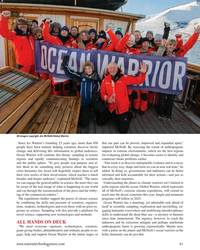 )
January 2024 - Marine Technology Reporter page: 41
)
January 2024 - Marine Technology Reporter page: 41All images copyright Jim McNeill/Global Warrior Since Ice Warrior’s founding 23 years ago, more than 450 that our part can be proven, improved and expanded upon,” people have been trained, helping scientists discover Arctic implored McNeill. By assessing the extent of anthropogenic change and delivering
-
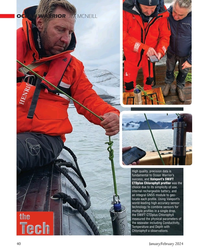 )
January 2024 - Marine Technology Reporter page: 40
)
January 2024 - Marine Technology Reporter page: 40OCEAN WARRIOR JIM MCNEILL High quality, precision data is fundamental to Ocean Warrior’s success, and Valeport’s SWiFT CTDplus Chlorophyll pro? ler was the choice due to its simplicity of use, internal rechargeable battery, and an integral GNSS module to geo- locate each pro? le. Using Valeport’s
-
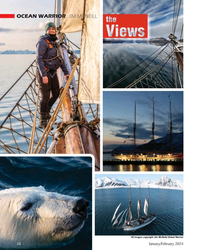 )
January 2024 - Marine Technology Reporter page: 38
)
January 2024 - Marine Technology Reporter page: 38OCEAN WARRIOR JIM MCNEILL All images copyright Jim McNeill/Global Warrior 38 January/February 2024 MTR #1 (34-49).indd 38 1/30/2024 4:56:02 PM
-
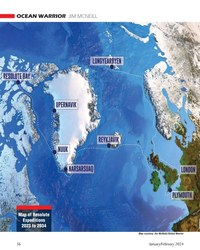 )
January 2024 - Marine Technology Reporter page: 36
)
January 2024 - Marine Technology Reporter page: 36OCEAN WARRIOR JIM MCNEILL Map of Resolute Expeditions 2023 to 2034 Map courtesy Jim McNeill/Global Warrior 36 January/February 2024 MTR #1 (34-49).indd 36 1/31/2024 1:55:59 PM
-
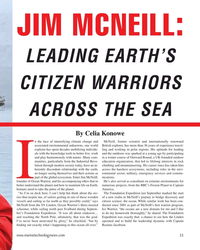 )
January 2024 - Marine Technology Reporter page: 35
)
January 2024 - Marine Technology Reporter page: 35JIM MCNEILL: LEADING EARTH’S CITIZEN WARRIORS ACROSS THE SEA By Celia Konowe n the face of intensifying climate change and McNeill, former scientist and internationally renowned associated environmental unknowns, one world British explorer, has more than 36 years of experience travel- explorer has
-
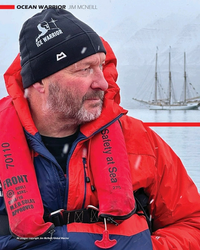 )
January 2024 - Marine Technology Reporter page: 34
)
January 2024 - Marine Technology Reporter page: 34OCEAN WARRIOR JIM MCNEILL All images copyright Jim McNeill/Global Warrior MTR #1 (34-49).indd 34 1/30/2024 4:07:08 PM
-
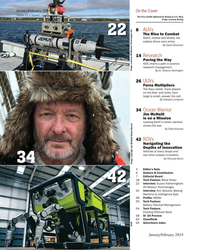 )
January 2024 - Marine Technology Reporter page: 2
)
January 2024 - Marine Technology Reporter page: 2Force Multipliers The Navy needs ‘more players on the ? eld’ and UUVs, from large to small, answer the call. By Edward Lundquist 34 Ocean Warrior Jim McNeill is on a Mission Leading Earth’s citizen warriors across the sea. By Celia Konowe 42 ROVs Navigating the Depths of Innovation Vehicles
-
 )
January 2024 - Marine Technology Reporter page: Cover
)
January 2024 - Marine Technology Reporter page: Coverto war? ghting, UUVs take quantum leaps in capability and duration The Rise of Combat AUVs Wave-Generated Offshore Renewable Microgrid Exploration Jim McNeill, Ocean Warrior Batteries Volume 67 Number 1 Thermal Management MarineTechnologyReporter Cover JanFeb2024 v3.indd 1 1/31/2024 8:32:49 A
-
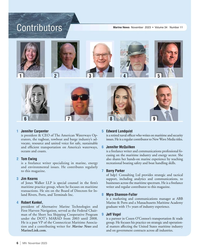 )
November 2023 - Marine News page: 6
)
November 2023 - Marine News page: 6skills. and environmental issues. He contributes regularly to this magazine. 7 Barry Parker of bdp1 Consulting Ltd provides strategic and tactical 3 Jim Kearns support, including analytics and communications, to of Jones Walker LLP is special counsel in the ? rm’s businesses across the maritime
-
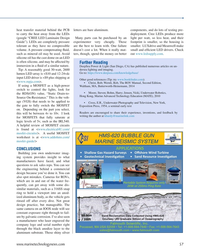 )
September 2023 - Marine Technology Reporter page: 57
)
September 2023 - Marine Technology Reporter page: 57heat transfer material behind the PCB letters are bare aluminum. components, and do lots of testing pre- to carry the heat away from the LEDs deployment. Cree LEDs produce more (google “CREE LED Luminaire Design Many parts can be purchased by an light per watt, so less heat, and their Guide”). LEDs
-
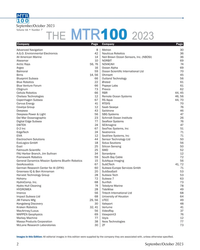 )
September 2023 - Marine Technology Reporter page: 2
)
September 2023 - Marine Technology Reporter page: 2Solutions 44 Sensor Technology Ltd 50 EvoLogics GmbH 18 Sidus Soutions 56 Exail 25 Silicon Sensing 50 Falmouth Scientifc 25 SMD 52 FAU Harbor Branch, Jim Sullivan 34 Sonardyne 12 Framework Robotics 59 South Bay Cable 72 General Dynamics Mission Systems Bluefn Robotics 15 SubAqua Imaging 56 GeoAcoustics
-
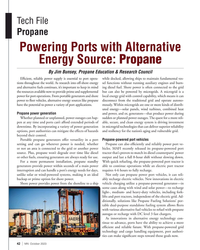 )
October 2023 - Marine News page: 42
)
October 2023 - Marine News page: 42Tech File Propane Powering Ports with Alternative Energy Source: Propane By Jim Bunsey, Propane Education & Research Council Ef? cient, reliable power supply is essential to port opera- while docked, allowing ships to maintain fundamental ves- tions throughout the world. As research into off-shore
-
 )
October 2023 - Marine News page: 6
)
October 2023 - Marine News page: 6Marine News October 2023 • Volume 34 Number 10 Contributors 1 24 35 9 7 6 8 10 1 Jim Bunsey uting writer for Marine News and MarineLink.com. is the director of commercial business development at the Propane Education & Research Council. 6 Edward Lundquist is a retired naval of? cer who writes
-
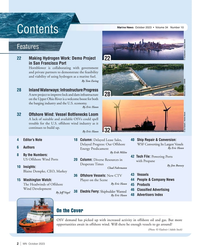 )
October 2023 - Marine News page: 2
)
October 2023 - Marine News page: 242 Tech File: Powering Ports US Offshore Wind Ports 20 Column: Diverse Resources in with Propane Desperate Times By Jim Bunsey 10 Insights: Chad Fuhrmann Blaine Dempke, CEO, Markey 43 Vessels 36 Offshore Vessels: New CTV 15 Washington Watch:
-
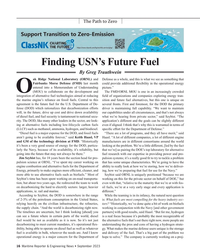 )
September 2023 - Maritime Reporter and Engineering News page: 16
)
September 2023 - Maritime Reporter and Engineering News page: 16the DOE’s top laboratory for alternative going into the future that may not always be there.” fuel research with our expertise in providing power and pro- Jim Szybist has, for 18 years been the section head for pro- pulsion systems; it’s a really good ? t to try to tackle a problem pulsion science at ORNL
-
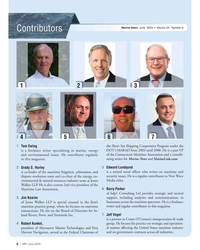 )
June 2023 - Marine News page: 6
)
June 2023 - Marine News page: 6LLP. He is also current 2nd vice president of the Maritime Law Association. 6 Barry Parker of bdp1 Consulting Ltd provides strategic and tactical 3 Jim Kearns support, including analytics and communications, to of Jones Walker LLP is special counsel in the ? rm’s businesses across the maritime
-
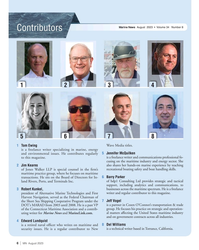 )
August 2023 - Marine News page: 6
)
August 2023 - Marine News page: 6Jennifer McQuilken to this magazine. is a freelance writer and communications professional fo- cusing on the maritime industry and energy sector. She 2 Jim Kearns also shares her hands-on marine experience by teaching of Jones Walker LLP is special counsel in the ? rm’s recreational boating safety
-
 )
May 2023 - Marine Technology Reporter page: 38
)
May 2023 - Marine Technology Reporter page: 38“I would not trade it for what I can do now, which is facilitate science on a much broader scale for all the scientists here and throughout FAU.” – Jim Sullivan, Executive Director, FAU Harbor Branch Oceanographic Institute Photo Greg Trauthwein It is the “throughout FAU” portion that is key, because
-
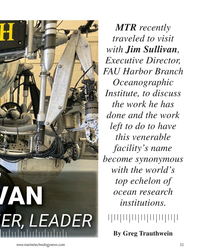 )
May 2023 - Marine Technology Reporter page: 35
)
May 2023 - Marine Technology Reporter page: 35MTR recently traveled to visit with Jim Sullivan, Executive Director, FAU Harbor Branch Oceanographic Institute, to discuss the work he has done and the work left to do to have this venerable facility’s name become synonymous with the world’s H top echelon of ocean research VAN institutions.
-
 )
May 2023 - Marine Technology Reporter page: 34
)
May 2023 - Marine Technology Reporter page: 34ACADEMIA FAU HARBOR BRANCH OCEANOGRAPHIC INSTITUTE ONE-ON-ONE WITH JIM SULLIV SCIENTIST, RESEARCHE Photo Greg Trauthwein 34 May/June 2023 MTR #4 (34-47).indd 34 6/1/2023 9:15:45 AM
-
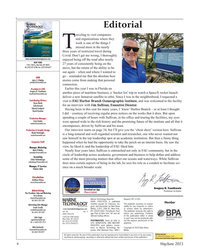 )
May 2023 - Marine Technology Reporter page: 4
)
May 2023 - Marine Technology Reporter page: 4, I requested a Contributing Writers visit to FAU Harbor Branch Oceanographic Institute, and was welcomed to the facility Kevin Hardy for an interview with Jim Sullivan, Executive Director. Celia Konowe Edward Lundquist Having been in this seat for many years, I ‘knew’ Harbor Branch – or at least I thought
-
 )
May 2023 - Marine Technology Reporter page: 2
)
May 2023 - Marine Technology Reporter page: 2the Waves Marine telemetry is helping out with species management and conservation. By Celia Konowe 34 Academia Scientist, Researcher, Leader Jim Sullivan’s position atop FAU 26 Harbor Branch Oceanographic Institute was an unexpected career zig. But he’s embraced the challenge and is building
-
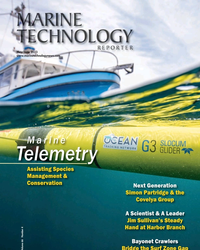 )
May 2023 - Marine Technology Reporter page: Cover
)
May 2023 - Marine Technology Reporter page: Cover.com Marine Telemetry Assisting Species Management & Conservation Next Generation Simon Partridge & the Covelya Group A Scientist & A Leader Jim Sullivan’s Steady Hand at Harbor Branch Bayonet Crawlers Bridge the Surf Zone Gap Volume 66 Number 4 MarineTechnologyReporter Cover MayJune2023
-
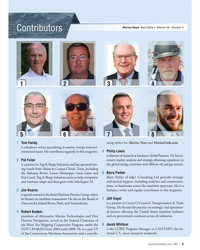 )
April 2023 - Marine News page: 5
)
April 2023 - Marine News page: 5and then grow with Subchapter M. and tactical support, including analytics and communica- tions, to businesses across the maritime spectrum. He is a 3 Jim Kearns freelance writer and regular contributor to this magazine. is special counsel in the ? rm’s Maritime Practice Group, where he focuses on
